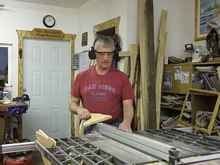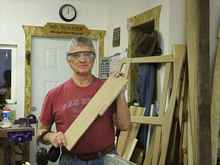Coulda' been a lot worse.
Even through the mouse ears, I heard the table saw change pitch. From a steady whirr, to that "zzzziiiinnnnnnngggggggg," like a ricochet in a cowboy movie. But, by the time anything registered, I was already crumpled up on the floor. And, I had been careful. Just, not careful enough.
I was making trim pieces. For the transition from Roughneck's cabin sides to cockpit coaming. Pieces that required some bevels and tapers and odd jogs to fit. The first side had gone pretty well. And, I was sort of congratulating myself on a good job, at least half done. Then, it was time to do the other side. Of course, this was a mirror-image problem. Everything would be upside down, and backward when it came time to cut and shape. My table saw only tilts one way. Usually, not such a big deal. If. If I can figure out which way to run the work piece.
This particular one had a significant jog along a beveled surface. I briefly considered using the band saw. But, I can usually get a cleaner cut with the table saw. And, after all. This was gonna' be the "last piece" in this particular clump. In my mind, it was actually already installed. I was already planning the next phase.
As I studied the setup, I "almost" grabbed a second push block. I have several of them in different thickness always within easy reach. Somehow, it just didn't seem necessary. (I guess that's strike two, huh?)
The idea was to set the blade at a ten degree slant. Set the rip fence at something like a 3-3/8" spacing from my thin-kerf Freud blade. I had to dispense with the zero-clearance insert to allow for the bevel cut. A narrow piece almost always gets a bit unstable as it passes the blade, without the zero-clearance fixture. (A foul tip to the bleachers, maybe?)
Then, it got interesting. The only way I could imagine how I would cut this jog, was to set the workpiece over a fully retracted blade, and slowly crank it up through, until the top cut sort of matched the pencil lines-and accept the wider cut on the bottom as a cost of doing business this way. (This was a second foul-tip that I, now, wish the catcher had snagged on the fly.)
 |
The “missile” will go in the scrap bin. I figured out another way to make it fit. There are always two or three push “sticks’ at the ready. A second one might have come in handy. If only, I had picked it up, that is… |
I scanned the collection of feather boards and both commercial and shop built hold downs at my disposal. The second push block beckoned. Nah. How was I gonna' crank the blade up with my one free hand. And, use a second push block in the same hand? And, besides that, a feather board would push irregularly against a jogged guide surface. Sure to bind up the blade and made things unsafe. Or, so I thought at the time.
Kate's a retired chief corpsman, with more Vietnam MEDEVAC casualty experience than she likes to talk about. My normal run of "owies" don't usually impress her much. But, as I came out of the barn doubled up and probably scowling in pain; I rapped on her sewing room window and motioned for her to meet me at the back door. I guess I was thinking clearly enough, that I might not managed a locked door. Anyhow, this time I had her attention. And fortunately, this time, I wasn't bleeding all over her hardwood floor. Just sort of stuck in the fetal position, trying to explain what had happened.
I don't really know what the launch velocity of an 18" long by about 5" wide piece of ¾" mdo plywood is. But, I have a rather obvious imprint of the very-square face imbedded into my stomach. And, I have an equally well imbedded recollection of how it got there.
Strike three came as I was about to complete my half-blind bevel cut. The blade was up enough. The cut was started. I attempted to change positions with my push-handle fixture, to keep the workpiece travelling per plan. And, that was an instant "game over."
It's been almost twenty years since the last time I did this sort of thing. Thousands and thousands of cuts later. I DID IT AGAIN!!
My best answer is that there are times when, even if you are paying attention, a particular tool is just not the proper choice for the job at hand. Maybe I blame the setup. Maybe a different way to hold the workpiece? Maybe I was in a bigger hurry than I care to recall. That is a constant threat around my lashup.
But, obvious is obvious. Rule One is that you should NEVER stand down range of a potential ballistic missile launch. Especially, one flying off a spinning 10-inch saw blade. Gee. I suppose that could also include those routers, and angle grinders, and sanders, and hand-held planer I've been using to speed up my current boat building project, too. Heck, as long as I'm trying on the sack cloth and ashes outfits for size; it's fair to admit to an occasional meteor strike from the drill press, and sliding miter saw, and let's not forget that bench mounted disc sander and spindle sander over in the corner. They all seem to knock a line drive at my head once in a while.
Yep. It coulda' been a whole lot worse. Like a ruptured spleen, or broken ribs, even internal bleeding for example.
New Rule One: "Engage brain prior to energizing saw."
And, happy boat building, all.
|








